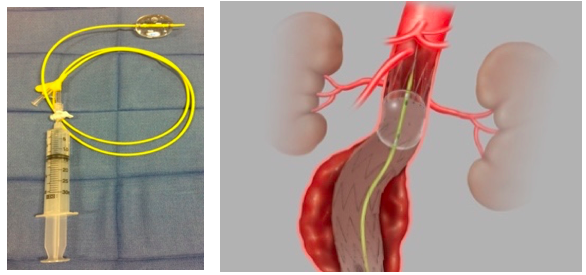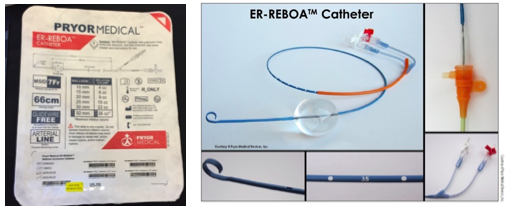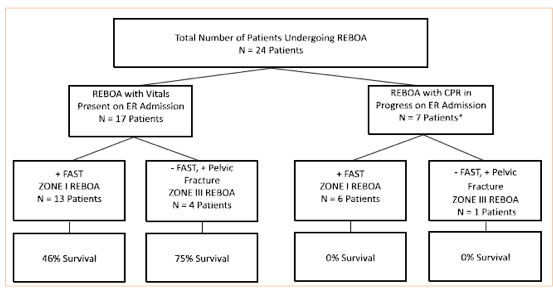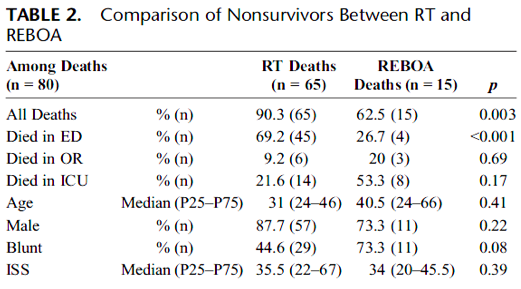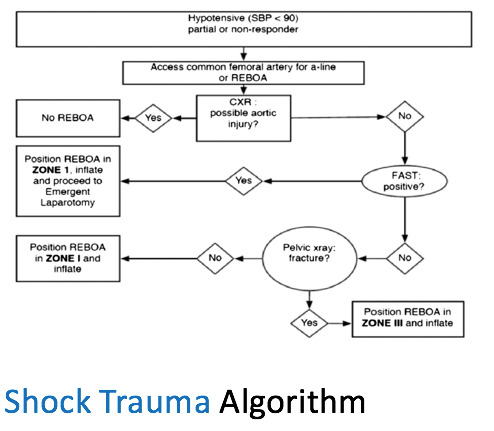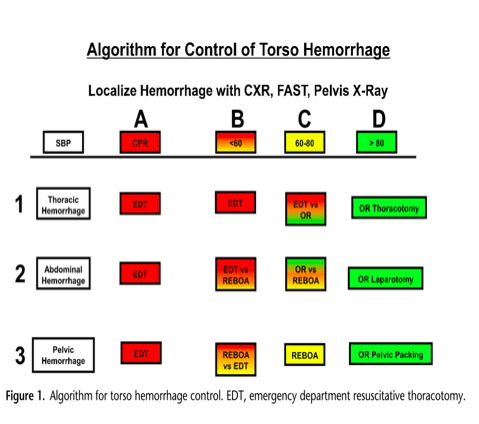References
1. Brenner, M. L., Moore, L. J., DuBose, J. J., Tyson, G. H., McNutt, M. K., Albarado, R. P., Rasmussen, T. E. (2013). A clinical series of resuscitative endovascular balloon occlusion of the aorta for hemorrhage control and resuscitation. The Journal of Trauma and Acute Care Surgery, 75(3), 506–11. http://doi.org/10.1097/TA.0b013e31829e5416
2. Davidson, A. J., Russo, R. M., DuBose, J. J., Roberts, J., Jurkovich, G. J., & Galante, J. M. (2016). Potential benefit of early operative utilization of low profile, partial resuscitative endovascular balloon occlusion of the aorta (P-REBOA) in major traumatic hemorrhage. Trauma Surgery & Acute Care Open, 1(1), e000028. http://doi.org/10.1136/tsaco-2016-000028
3. DuBose, J. J., Scalea, T. M., Brenner, M., Skiada, D., Inaba, K., Cannon, J., … Poulin, N. (2016). The AAST prospective Aortic Occlusion for Resuscitation in Trauma and Acute Care Surgery (AORTA) registry. Journal of Trauma and Acute Care Surgery, 81(3), 409–419. http://doi.org/10.1097/TA.0000000000001079
4. GUPTA, B. K., KHANEJA, S. C., FLORES, L., EASTLICK, L., LONGMORE, W., & SHAFTAN, G. W. (1989). The Role of Intra-aortic Balloon Occlusion in Penetrating Abdominal Trauma. The Journal of Trauma: Injury, Infection, and Critical Care. http://doi.org/10.1097/00005373-198906000-00026
5. Hughes, C. (1954). Use of an Intra-Aortic Balloon Catheter Tamponade for Controlling Intra-Abdominal Hemorrhage in Man. Surgery, 36(1), 65–8. Retrieved from http://www.ncbi.nlm.nih.gov/pubmed/13178946
6. Johnson, M. A., Neff, L. P., Williams, T. K., & DuBose, J. J. (2016). Partial Resuscitative Balloon Occlusion of the AORTA (P-REBOA). Journal of Trauma and Acute Care Surgery, 1. http://doi.org/10.1097/TA.0000000000001146
7. Kauvar, D. S., Lefering, R., & Wade, C. E. (2006). Impact of hemorrhage on trauma outcome: an overview of epidemiology, clinical presentations, and therapeutic considerations. The Journal of Trauma, 60(6 Suppl), S3-11. http://doi.org/10.1097/01.ta.0000199961.02677.19
8. Low, R. B., Longmore, W., Rubinstein, R., Flores, L., & Wolvek, S. (1986). Preliminary report on the use of the percluder® occluding aortic balloon in human beings. Annals of Emergency Medicine, 15(12), 1466–1469. http://doi.org/10.1016/S0196-0644(86)80945-3
9. Moore, L. J., Brenner, M., Kozar, R. A., Pasley, J., Wade, C. E., Baraniuk, M. S., … Houston, T. (2014). Implementation of resuscitative endovascular balloon occlusion of the aorta as an alternative to resuscitative thoracotomy for noncompressible truncal hemorrhage. J Trauma Acute Care Surg, 79(4), 523–532. http://doi.org/10.1097/TA.0000000000000809
10. Morrison, J. J., Ross, J. D., Markov, N. P., Scott, D. J., Spencer, J. R., & Rasmussen, T. E. (2014). The inflammatory sequelae of aortic balloon occlusion in hemorrhagic shock. Journal of Surgical Research, 191(2), 423–431. http://doi.org/10.1016/j.jss.2014.04.012
11. Okumura, E., Tsurukiri, J., Oomura, T., Tanaka, Y., & Oomura, R. (2016). Partial resuscitative endovascular balloon occlusion of the aorta as a hemorrhagic shock adjunct for ectopic pregnancy. The American Journal of Emergency Medicine, 34(9), 1917.e1-1917.e2. http://doi.org/10.1016/j.ajem.2016.02.026
12. Saito, N., Matsumoto, H., Yagi, T., Hara, Y., Hayashida, K., Motomura, T., … Wagatsuma, Y. (2015). Evaluation of the safety and feasibility of resuscitative endovascular balloon occlusion of the aorta. J Trauma Acute Care Surg, 78(5), 897–904. http://doi.org/10.1097/TA.0000000000000614
13. Sano, H., Tsurukiri, J., Hoshiai, A., Oomura, T., Tanaka, Y., & Ohta, S. (2016). Resuscitative endovascular balloon occlusion of the aorta for uncontrollable nonvariceal upper gastrointestinal bleeding. World Journal of Emergency Surgery. http://doi.org/10.1186/s13017-016-0076-3
14. Sauaia, A., Moore, F. A., Moore, E. E., Moser, K. S., Brennan, R., Read, R. A., & Pons, P. T. (1995). Epidemiology of Trauma Deaths. The Journal of Trauma: Injury, Infection, and Critical Care, 38(2), 185–193. http://doi.org/10.1097/00005373-199502000-00006
15. Williams, T. K., Neff, L. P., Johnson, M. A., Ferencz, S.-A., Davidson, A. J., Russo, R. M., & Rasmussen, T. E. (2016). Extending resuscitative endovascular balloon occlusion of the aorta. Journal of Trauma and Acute Care Surgery, 81(2), 294–301. http://doi.org/10.1097/TA.0000000000001075
16. Yamashita, Y., Kawashima, A., Hasegawa, J., Oba, T., Nakamura, M., Yamashita, T., … Sekizawa, A. (2016). Intra-aortic balloon occlusion without fluoroscopy for life-threating post-partum hemorrhage. Case Reports in Perinatal Medicine, 5(1), 19–22. http://doi.org/10.1515/crpm-2015-0050
